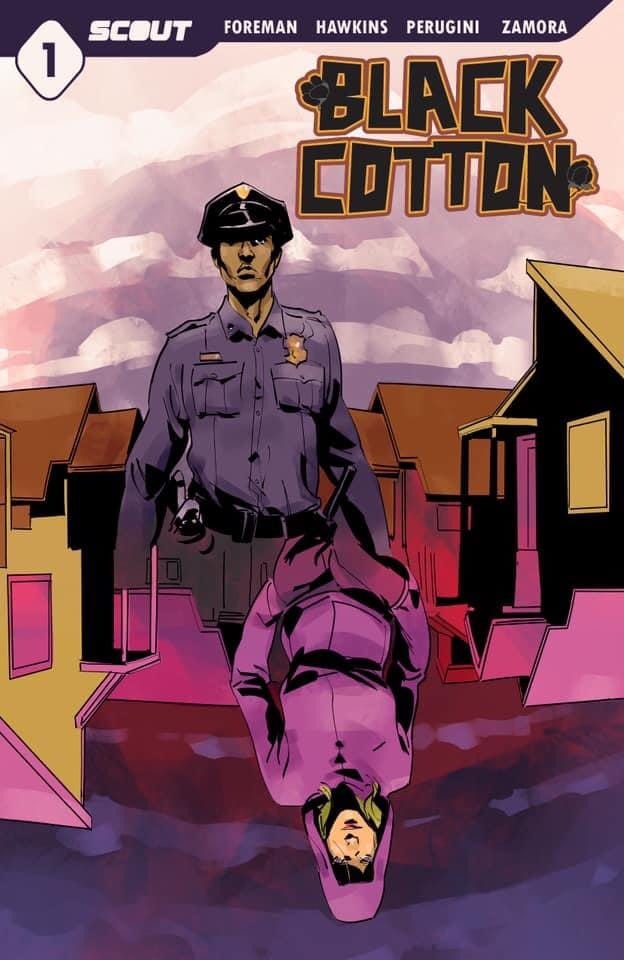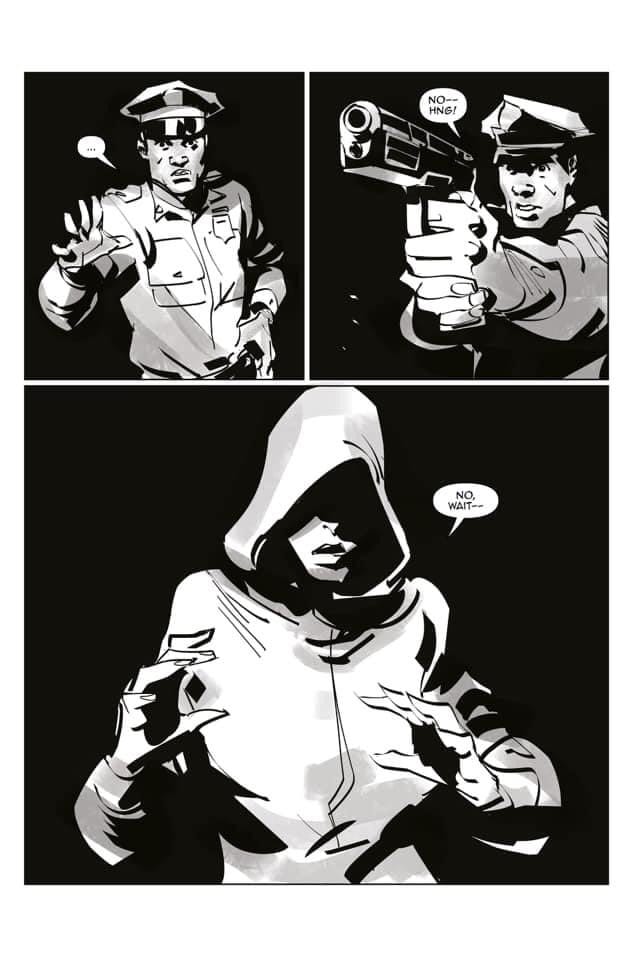Black Cotton is an alternate reality series coming out this February from Scout Comics. The series is by co-writers Brian Hawkins and Patrick Foreman, artist Marco Perugini, letterer Francisco Zamora, and graphic designer Jerry Nilsson. Monkeys Fighting Robots got the chance to speak with the co-writers about the new series.
About the series:
Set in an alternate reality where the social order of “white” and “black” is reversed, an elitist family, the Cottons, are rocked by a tragic shooting that begins to unravel long-standing family secrets that could not only destroy the family but also divide the fragile social climate of the world.
MFR: At first glance, the most noticeable aspect of this comic is it is in greyscale. What inspired this choice? Was it intentional, even at the writing stage of this comic?
Brian Hawkins: I’m definitely a fan of grayscale. That goes back to The Walking Dead for sure. But the choice for black and white/grayscale for Black Cotton was definitely story-based. We talked about it early, the grittiness of it, and since it is a story about black and white, i.e., “color,” to take color out of it — seemed poetic and right — also, it allows you to focus on the characters and to see them “without color” for who they are through the lens of social order in this universe.
Patrick Foreman: Absolutely. We talked about trying to remove people’s implied bias or preconceived perceptions. After talking about it out for hours, we both thought the best way to accomplish it would be to simply remove the colors.
MFR: What was the collaborative process like? Did you encounter any obstacles when trying to create the story and its world?
HAWKINS: No obstacles at all! Patrick and I really complement each other well. He’s a consummate collector and has been for years, and I’m definitely a comic book enthusiast. We bring a lot of the same ideology to the table but also a healthy difference, and that creates a great balance. As far as the process goes — we talk on the phone; we have weekly zoom meetings to craft story while also talking about the business side of comic book creation and how to build the Black Cotton brand. Once we’ve outlined the story, I would then script.
FOREMAN: None. Brian and I work great together. We both have a high level of respect for each other and our creative ideas. Brian is a seasoned veteran with several books under his belt. Throughout this process, he has shared so much knowledge with me. I will forever be grateful for his guidance. Black Cotton would not be a reality if he had not taken me under his wing with this collaboration. It has been great, and I am sure it will be great 10 years from now too.
MFR: I think it’s safe to say that Black Cotton deals with significant, current issues. But, what was the idea behind the choice to set the story in an alternate reality?
HAWKINS: We wanted the freedom of having a world like ours but not ours. We didn’t want the same sordid history that we actually have as a bedrock in the real world to be the same foundation for this story.
So in Black Cotton, we see a world that is like ours, but not reversed in many ways, but not just reversed in a lot of ways — also different. The similarities that we see as readers, we are taking into the story with us from our world, and what we have to deal with is our own implicit bias, but the Black Cotton Universe/Reality isn’t a world where things diverged to make the reality different– it’s actually a reality where Africans never came to America as slaves. And White Americans were never slaves either, so it’s not a reverse as in a flip-flop.
It’s a holistic reversal, truly another perception of reality to challenge how we perceive this reality, ultimately to bring about a higher level of understanding of the human condition. So, in the Black Cotton Universe, we are dealing with a reality where oppression has taken place without slavery- so we see some of the same horrible mentalities and ills and brutality even without slavery having ever been present.
FOREMAN: I believe it all began with the famous and one of the most asked questions; “What if…” Once you start there, then it is easy to go down a rabbit hole with the right topic. With all of the events that have happened just over the past 10 years, more and more people are secretly asking questions such as “if that happened to..”, “If they were…”, “If they could only see it from…” Many times conversations are hard to have because the participants do not feel they are in a safe zone to partake in the dialog. We wanted to create a masterpiece that people would enjoy while also creating a safe environment where readers could walk in other people’s shoes. We want people all around the world to start engaging in fresh, new conversations.
MFR: What can you tell us about the Cottons, this series’ protagonists?
HAWKINS: They are a family of immense wealth. As far as fictional billionaires go, think Carringtons from the TV show, Dynasty. The Cottons are an elitist family, what would be considered in our world as being part of the One Percent. They are historically wealthy, dating as far back as over 400 years (which is purposely stated as four hundred year because it parallels our real-world history of slavery). The Cottons were immigrants from Africa, among other African immigrants, who ended up settling in the Americas. No one took from the Native Americans or any original settlers, but instead bargained and, in some instances outwitted, there were various and different ways and methods by which the African immigrants came into power aka the ruling class of America — but that’s a different story that we will delve into later.
So, when the story starts here — the Cottons are a strong family unit that rallies around their own mantra of “Black Cotton,” which is a mindset for them as a family as well as how they made their money… Literally manufacturing black cotton. The family dynamic consists of Elijah Cotton, the patriarch, Jaleesa Cotton, the matriarch, Zion Cotton, the oldest brother and also a police officer, Qia Cotton, the only daughter and also COO of Black Cotton Ventures, and Xavier Cotton, the youngest brother and teenager. We will explore that Black Cotton mindset throughout the comic… This segues perfectly into the next question…
MFR: At the press release for the series, Brian Hawkins noted that “Black Cotton” is a comic, but it’s also a mindset; it’s a mindset that’s being explored in a comic. Could you both elaborate on this quote?
HAWKINS: Black Cotton as a mindset is about love, honoring familial bonds, kinship, empowerment, encouragement, edification, enlightenment, and most definitely self-reliance. “Black Cotton” represents tenets that are rooted in the essence of what makes a person a full human being, perfect in the sense of existing as a human being that can mature and grow as you’re supposed to, understanding that there is no separation between individual and group, that one is a part of the other; it takes individuals to make a group, to form a whole, and they have to strive for the best version of themselves to better not only themselves but others. That’s Black Cotton.
FOREMAN: Black Cotton Mindset is going back to the beginning before perception occurs. Black Cotton Mindset is color blind and curious like newborn babies’ minds are. It is there that people are able to cross the implied stereotype boundaries we have unknowingly developed over the years.
MFR: Do you have any piece of advice for comic book writers or comic creators, in general?
HAWKINS: Work on your craft first — if you’re a writer, write and really understand the storytelling structure as it pertains to comic book writing. The same goes for artists — even though I cannot speak directly to that as a writer — but I can as an editor; I know that the artist has to be telling the same story as the writer; their canvas is just a different part of that whole (that goes back to the Black Cotton mindset of individuals = the whole, right?).
So, craft, again — how do I tell this story through art? How do I bring it to life? There’s a method to that which goes along with vision. This is where the second part comes in, collaboration. Comic book writing and creating as a whole is about collaborating and thus, communication and openness is a necessity. You have to go into that willingly. Again, the individual becomes the group, to make the whole (that’s Black Cotton again!)
Last, is limitation. Ideas can be vast, and most creators want to just create, create, create, but it takes limiting yourself to focus, to really bring something to life. You have to embrace the idea that you have time and that you do not have to do it all now to be a creator. It took me a while to learn that and then even longer to put it into practice. Presently, I have a few projects coming out, finally coming to life, but it isn’t because I’ve just been on a rampage of creating — I began to limit myself years ago, focusing on project by project, saying ‘no’ to myself a lot of times when I wanted to start something new without finishing what I’d already started and now some of those projects are coming to fruition. It’s the simplest lesson but the hardest to grasp: Less is more.
FOREMAN: Always have a Mentor. Having a mentor helps you continue to grow and get better with your craft. Never lose your vision. Write your vision down, and then build your team around that vision. The team will determine how far you can go. The Black Cotton team is truly special and operates as one. This makes the whole process enjoyable. It is within that type of environment that legendary masterpieces are created.
MFR: Thank you for taking the time to talk with us, and best of luck with Black Cotton.
You can pre-order the first issue in December or pick it up when it hits local comic book shops this February from Scout Comics.





